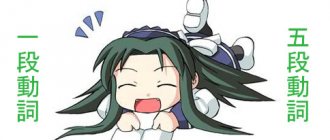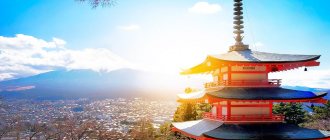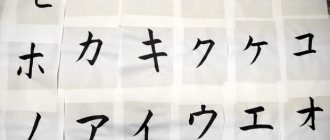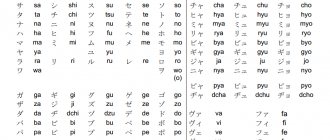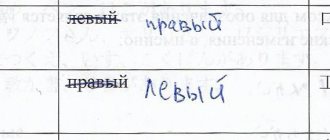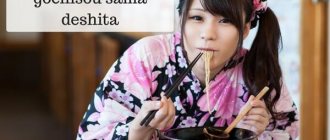Learn Hiragana!
Hiragana is the phonetic alphabet used in the Japanese language. Because it covers all the sounds used in the language, anything can be written in hiragana. This alphabet is a mandatory part of the curriculum at a language school in Japan.
- Hiragana has 46 characters, each representing a vowel sound or a combination of a vowel and a consonant.
- Use hiragana to write gerunds and expressions or words that are rare and may be unknown to the reader.
- Make flashcards for each hiragana character and write the sound it represents on the back. Practice by walking past them once or twice a day and saying the sounds. Then try looking at the audio recording and writing the corresponding hiragana character.
How to say "Japanese" in Japanese?
I bring to your attention a post about the Japanese language. This time I will tell you about a simple way to form the names of languages and nationalities. As in many Asian languages, this can be done by simply adding the desired word (person or language) to the name of the country. But there is no language in the world where there are no exceptions to the rules. And you will learn about them by reading this post to the end. So let's get started!
Instead of introducing
Reading Notes. Here and below, the reading written in Hiragana alphabet broken down into words (if the text contains hieroglyphs) is indicated in square brackets. If you hover your mouse over the Latin reading, the Cyrillic reading will appear (closer to the pronunciation). Vowels with a colon such as a:, i:, u:, e:, o: are long, pronounced longer than their short equivalents without a colon. In Latin they are written aa, ii, uu, ei (or ee), ou (or oo), respectively. The "。" at the end of a sentence is just the Japanese version of a period, and the "、" is a comma. The Hiragana sign は is read as HA, but as a case indicator, for example in sentences like AはBです(A wa B desu), etc. it is read as BA, or rather UA (as in English W, the average between Russian B and U ). The U sound at the end of words is usually not pronounced at all.
Country names
Previously, the names of countries were formed using the hieroglyph 国[くに] (kuni) country, state, or simply hieroglyphs with the appropriate reading, so to speak, in the Chinese manner. For example Russia was 露国[ろこく] (rokoku) or 露西亜[ろしあ] (roshia). But in modern Japanese, the names of countries (except Japan, China and Korea) are not written in hieroglyphs. In general, they are borrowed words (most often from English), therefore they are written in Katakana. Exceptions include some Asian countries, including Japan.
| ロシア | roshia | Russia |
| 越南[べとなむ], more often ベトナム | betonamu | Vietnam |
| 泰国[たいこく], more often タイ国 | taikoku | Thailand |
| イギリス | igirisu | Great Britain |
| フランス | furansu | France |
| ドイツ | doitsu | Germany |
| スペイン | supein | Spain |
| アメリカ | America | USA |
| BUT | ||
| 日本[にほん/にっぽん] | nihon / nippon | Japan |
| 中国[ちゅうごく] | chuugoku | China |
| 韓国[かんこく] | kankoku | (South Korea |
Language names
Just add the character 語[ご] (go) to the name of the country to get the name of the language. But there may be exceptions. For example, English or Arabic. Country + 語 = Language
| 日本語[にほんご] | nihongo | Japanese |
| ロシア語 | roshiago | Russian language |
| 英語[えいご] | eigo | English language |
| フランス語 | furansugo | French |
| ベトナム語 | betonamugo | Vietnamese language |
| 中国語[ちゅうごくご] | chuugokugo | Chinese (common name) |
| 北京語[ぺきんご] | pekingo | Chinese (Mandarin, Beijing Chinese) |
| インドネシア語 | indonesiago | Indonesian |
| アラビア語 | arabiago | Arabic |
| 外国語[がいこくご] | gaikokugo | foreign language |
Names of nationalities
Formed using the character 人[じん] (jin). Country/city + 人 = Nationality/resident
| 日本人[にほんじん] | nihon jin | Japanese |
| ロシア人 | roshia jin | Russian |
| フランス人 | furansu jin | Frenchman |
| イタリア人 | itaria jin | Italian |
| 韓国人[かんこくじん] | kankoku jin | Korean |
| ドイツ人 | doitsu jin | German |
| インド人 | indo jin | Indian |
| ベトナム人 | betonamu jin | Vietnamese |
| スペイン人 | supein jin | Hispanic |
| 大阪人[おおさかじん] | oosaka jin | Osaka resident |
| 東京人[とうきょうじん] | toukyou jin | Tokyo resident |
| モスクワ人 | musukuwa jin | resident of Moscow |
| パリス人 | Parisu Jin | resident of Paris |
| 外国人/外人[がいこくじん/がいじん] | gaikoku jin / gai jin | foreigner |
And some examples: roshiago-o hanasu) = In Russia, Russians speak Russian. [かれはベトナムごができない] (kare wa betonamugo ga dekinai) = He doesn't speak Vietnamese. ブラジルに住んでいますか。[ブラジルにすんでいますか] (burajiru ni sunde imasu ka) = Do you live in Brazil? I speak a little Japanese. (Chan-san wa taijin dewa arimasen) = Chan is not Thai. きみのフレンドはアメリカじんですか] (kimi-no furendo wa amerikajin desu ka) = T howl friend is an American? 今はインドにいる。[いまはインドにいる] (ima wa indo-ni iru) = I am in India now.
Now you know how to quickly form this or that name. Try to make up a few names and sentences with them yourself and share them in the comments.
Dictionary
| № | Japanese | Reading | Meaning |
| 1 | いる | iru | to be, to be in, to have (about animate) |
| 2 | 住む[すむ] | sumu | live |
| 3 | 話す[はなす] | hanasu | speak |
| 4 | 出来る[できる] | dekiru | be able to, be able to |
| 5 | 国[くに] | kuni | a country |
| 6 | 語[ご] | go | language |
| 7 | 人[じん] | jin | Human |
| 8 | フレンド | furendo | friend, girlfriend |
| 9 | 君[きみ] | kimi | You |
| 10 | 彼[かれ] | kare | He |
| 11 | 今[いま] | ima | Now |
| 12 | ちょっと | chotto | A little |
| 13 | -さん | san | polite suffix, usually translated as "mister/lady" |
Related Posts
Learn katakana!
Katakana consists of 46 characters that represent the same sounds as hiragana, but they are used to write words of foreign origin.
- Since Japanese does not have long vowels, all long vowels in katakana are indicated by an em dash after the character. For example, "ケーキ" is how you say "cake" in English. The dash indicates a long "a" sound.
- Hiragana and katakana can be learned in a few weeks if you practice them for a few hours every day.
Application of Hiragana and Katakana
Why do the Japanese need two alphabets? Historically, the Hiragana alphabet has been used to write grammatical particles and inflected parts of words . Hiragana can be used to write Japanese words – for example, if you don’t know how to write a word in a hieroglyph. It is also used in some texts as hints, written in small print next to the kanji to make it easier to determine how it is read. This is why hiragana is the main alphabet in Japanese writing. It begins with familiarization with the language, laying the foundation for reading and understanding what is written.
Katakana is primarily used to write foreign names and loanwords : for example, the Japanese words "pen" (from English "pen") and "banana" (from English "banana") will be written in this alphabet. Your names will also be written in katakana.
Katakana characters are simpler in design and more angular, previously they were used only by men, while hiragana is more rounded, the lines are smooth: it was invented by Japanese court ladies. As we can see, the character of the writing of the features reflects the male (katakana) and female (hiragana) character.
Learn Handwritten Fonts
Just as our letter "a" looks different on a computer than in handwriting, many computer fonts in Japanese look different from handwritten ones.
- Remember. A good way to learn is to spend half an hour to an hour a day memorizing and writing characters.
- Test yourself. To check if you remember hiragana and katakana, try writing a specific group of sounds from memory. Make a list of all the sounds, then try to match them with the hiragana and katakana characters. Practice daily until you can remember 46 symbols for each alphabet.
Male names in Japanese
- Alexander - (defender) - Mamoru
- Alexey – (assistant) – Taske
- Anatoly – (sunrise) – Higashi
- Andrey - (courageous, brave) - Yukio
- Anton – (competing) – Rikishi
- Arkady - (happy country) - Shiavakuni
- Artem – (unharmed, in perfect health) – Andzen
- Arthur - (big bear) - Okuma
- Boris – (struggling) – Toshiki
- Vadim – (proving) – Syomei
- Valentine – (strong, healthy) – Tsuyoshi
- Valery – (vigorous, healthy) – Genkito
- Vasily – (royal) – Obu
- Victor – (winner) – Serisha
- Vitaly (life) – Ikiru
- Vladimir (ruler of the world) – Heivanushi
- Vyacheslav (illustrious) – Kagayakashi
- Gennady – (noble, highborn) – Koketsu
- Georgy (farmer) – Nofu
- Gleb (block, pole) - Burokku
- Gregory (awake) - Meosamashi
- Daniel (divine judgment) - Kamikoto
- Demyan – (conqueror, pacifier) – Seifuku
- Denis – (vital forces of nature) – Shizenryoku
- Dmitry (earthly fruit) – Kajitsu
- Eugene (noble) - Ryoidenshi
- Egor (patron of agriculture) – Dzinushi
- Emelyan - (flattering, pleasant in words) - Kangen
- Efim (blessed) - Megumaro
- Ivan – (the grace of God) – Kaminoonto
- Igor – (militancy, courage) – Yujiro
- Ilya - (Fortress of the Lord) - Yosaishu
- Kirill – (lord of the sun) – Tayenoröshü
- Constantine (regular) - Eizoku
- Leo (lion) – Shishio
- Leonidas (son of the lion) – Shishikyu
- Maxim (great) - Mattakushi
- Michael (Godlike) - Kamizu
- Nikita (victorious) - Shorito
- Nicholas (victory of the people) - Hitonosori
- Oleg (light) - Hikaro
- Pavel (small) - Shoshi
- Peter (stone) - Ishi
- Roman (Roman) - Roman
- Ruslan (solid lion) - Shishihado
- Tigran (generous person) - Kiretego
- Sergei (high, highly respected) - Tattobu
- Stanislav (become famous) - Yumainar
- Stepan (crown, wreath, crown) - Hanavaro
- Yuri (creator) - Yarite
- Yaroslav (bright glory) - Akarumei
Japanese
Japanese schoolchildren in their native language lessons study a subject that is not called “Japanese language” (nihongo), but “the language of the country,” “national language” (kokugo).
From an ideological point of view, Japan is a country of one language and many of its dialects.
Japanese
, Japanese (English), in Japanese 日本語 in hieroglyphs or にほんご in the hiragana syllabary
(read “nihongo”)
, 日语
(simplified Chinese, read “zhiyu” in Chinese)
- the official language of Japan (de facto, not specified by law ). [1] The number of native speakers in the country and abroad is approximately 126 million people. [2]
In Russia, according to the 2002 population census, 24,787 people speak Japanese. [3]
Japanese language. Is it easy to learn?
How can I answer the question, what is it like to learn Japanese?
Difficult, like any other foreign language!
But the question arises: how much more difficult than others? After all, Japanese is considered one of the most difficult! In other respects, just like Russian.
So, I talked to people who learn Korean or Chinese. And I got the feeling that I really chose a more complex language. And now I’ll tell you why I think so.
1) “ABC”
Of course, Japanese doesn't really have alphabets. Because their letters mainly have syllabic meaning and sound. And so, they have TWO
“ABCs”: hiragana and katakana. They look completely different, but in fact they read exactly the same.
Then the question arises, why do they need two “identical” ones? And the answer is simple!
To write native words, hiragana is used, but for foreign words, names, or to highlight an important word in the text, katakana is used.
For example:私はクリスティーナです
。Readable
, and it translates, as you guessed,:
I am Christina .
“:” – in transcription means a long vowel sound. It is also worth mentioning that the Japanese do not have the “L” sound. They replace it with “R”. The peculiarities of the speech apparatus do not allow them to pronounce “L”, and even by ear they perceive them in the same way.
They do not have closed syllables.
That is, there are no syllables that end in a consonant, but there is a pronunciation rule in which the vowel sound is almost swallowed and the effect of a closed syllable is created. So, in the example you might have noticed that one letter was written in small letters:ィ. No, she is not like that on her own. They just don’t have the syllable ti, which means they need to create it. Therefore, ィ テ[te] and we get [ti].
2) Kanji
You know them like hieroglyphs. Yes, yes, those same Chinese characters. The Japanese use them very actively! By the way, in the previous example you saw one:私
[watashi] – me.
You may ask, what is the problem? Take it and learn it!
Oh, if only it were so simple! The fact is that in Japan, hieroglyphs have two readings: Japanese and Chinese (it’s only called that, a Chinese person is unlikely to understand you). And in addition to this - many meanings! But what's even worse is that different kanji can be read the same! Below is an example from my dictionary:
And if you think that your suffering will end there, you are mistaken. Depending on the part of speech, the endings of the kanji will change, and if it is a verb, then brace yourself! There you will have a bunch of forms depending on the situation, time and other factors. You will have to remember at least a dozen endings.
But the most offensive thing is that there is much less kanji in Korean. And at first, for easy communication, you may not even know them at all. Chinese is understandable, but they don’t have two more alphabets.
3) Time
Although this is not the most difficult moment, it sometimes causes confusion. The Japanese only have two hours! Past and future-present. And to explain the logic of the last complex thing, but starting to practice you understand it, but to explain it is still terribly difficult.
4) No clear translation
Yes, you heard it right! There are phrases where everything is clear, but it happens that the same phrase can in one case be translated as “thank you”
, and in the other
“please”
. They also have words that, although they have translations in Russian-Japanese and English-Japanese dictionaries, actually have no meaning and are simply an indicator of something.
And ordinary sentences sometimes raise questions about how to translate correctly. Therefore, be prepared for the fact that first you translate literally, and then adapt the translation. Otherwise, you may end up with “Which side are you on?”
instead of
“Where are you from?/What country are you from?”
5)Indicators
I admit that they are very useful! Especially considering that they write everything together, without spaces, the indicators really help you navigate and find the topic, the main object of the sentence, the location of the action, the purpose of the action, etc. But when you’re just learning all this, you have to think carefully when writing sentences.
6) Emotional endings of sentences
In fact, there are no question marks or anything in Japanese! But they have ways to show what they want, and special indicators help them with this. If this is a question, then at the end of the sentence it will beか
.
If it ends inね
, then they ask, assuming that the interlocutor agrees with them or will agree.
For example, “This is delicious, isn't it?”
.
かしら
shows your uncertainty, for example
“It will probably rain tomorrow.
“ . And these are not the only indicators.
I guess I'll finish here. Here I talked about what caused difficulties for me and what I did not hear in other languages.
But I want to note that learning a language is very interesting! Yes, sometimes it’s difficult, even too difficult, but life itself is not a simple thing. I am in no way dissuading you! I just wish you good luck if you are going to take up this language, and, of course, patience!
If in doubt, go to the Foreign Languages Festival at HSE. This will help you with your choice.
Article source: https://zen.yandex.com/media/id/5d91bca82beb4900b3038392/iaponskii-iazyk-legko-li-vyuchit-5e410a5dc0c2cd2f40ec8bc4



